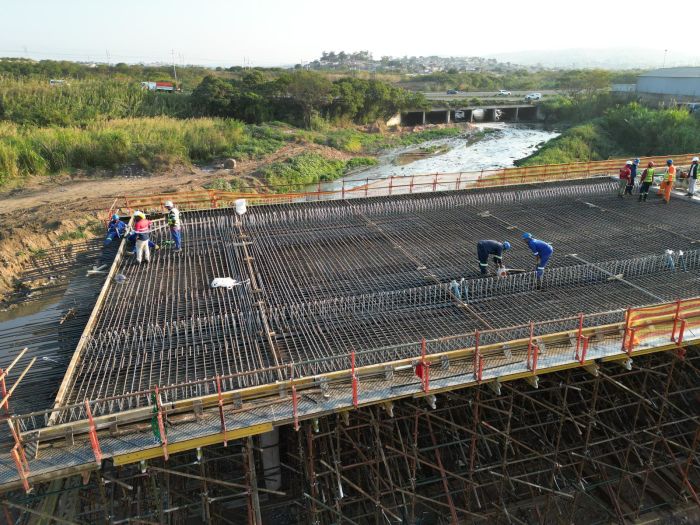






Following the devastating floods of April 2022 in KwaZulu-Natal, the eThekwini Metropolitan Municipality initiated a project to replace two washed-away bridges in Durban, South Africa with integral bridge structures. Integral bridges feature a fully monolithic deck connected to piers and abutments, offering a highly robust solution for high-water flooding cases. This design prevents the deck from becoming buoyant and floating off the supports, as may occur with conventional decks on bearings and joints.
As integral bridges are fairly complex structures, representatives from the eThekwini Metropolitan Municipality and the University of Pretoria decided to monitor the long-term behavior of the two newly constructed integral bridges. The project features a new construction method, using Campbell Scientific's reliable measurement systems to provide crucial data for monitoring the bridges' health over time.
Campbell Scientific worked with Geo Installations to supply a state-of-the-art bridge health monitoring system for the two bridges. The bridge sensors were installed during the construction phase.
The Challenge
Traditional jointed bridge designs incorporate expansion joints that allow movement of the bridge deck to accommodate temperature fluctuations and structural shifts over time. These joints and bearings, however, require frequent maintenance, making them costly in the long term.
In Durban, the new bridges are integral structures, eliminating expansion joints altogether. The deck is directly connected to the bridge piers and abutments, resulting in additional environmental stresses on the structure. This posed a unique design challenge: the need to monitor the increased strain and the overall behavior of the bridge over time, especially given the region’s vulnerability to extreme weather events, such as the flooding that devastated the area in 2022. Accurate, long-term monitoring is essential to ensure that these new bridges remain safe and resilient.
The Solution
The comprehensive bridge health monitoring system includes:
- Vibrating wire (VW) strain gauges installed on the bridge deck to measure internal strain and deformation
- Thermistor strings installed in the bridge deck to monitor temperature fluctuations
- Shape acceleration arrays (SAA) placed inside the abutment to monitor lateral movement
- Earth pressure cells installed on both abutments of the bridges to measure earth pressure acting on the structure
- Weather stations deployed to provide local environmental data for correlation with bridge performance
Campbell Scientific’s equipment not only ensures precise data acquisition but also allows for real-time bridge-performance analysis. The data are automatically collected, securely stored, and easily shared with engineers and stakeholders for continuous monitoring. Our equipment’s ease of use and long-term reliability ensure that the monitoring system will function efficiently for years to come.
The Benefits
The bridge health monitoring system delivers numerous benefits and helps the stakeholders understand the structural behavior better:
- Improved Safety and Reliability: By continuously monitoring the bridges' structural performance, we are helping engineers detect potential issues before they become critical. This proactive approach helps prevent structural failures.
- Cost-Effective Solution: Eliminating expansion joints reduces maintenance costs associated with traditional bridges. The automated nature of Campbell Scientific’s monitoring system minimizes manual intervention, lowering the overall cost of long-term monitoring.
- Long-Term Insight into Bridge Behavior: The data gathered through our system will provide valuable insights into how these new types of integral bridges behave under various environmental conditions. This knowledge can direct future bridge design and construction practices, improving infrastructure resilience across South Africa.
- Sustainable Infrastructure: The innovative construction method used in this project, coupled with our advanced monitoring system, supports the development of more durable, resilient bridges. This sustainability is particularly important in flooding-prone regions, where infrastructure plays a crucial role in recovery and stability.
Campbell Scientific remains committed to reducing uncertainty in structural and geotechnical applications and helping improve the quality of life on our planet by providing reliable, scalable, and efficient monitoring solutions. Through this project, we are contributing to the advancement of engineering practices that prioritize infrastructure resilience.
案例总结
应用
Monitoring strain and bridge behavior over time for extreme flood events位置
Durban, South Africa参与机构
eThekwini Metropolitan Municipality, University of Pretoria, Geo Installations测量参数
Internal strain and deformation, temperature fluctuations, lateral movement, structural earth pressure, local environmental conditions查看PDF